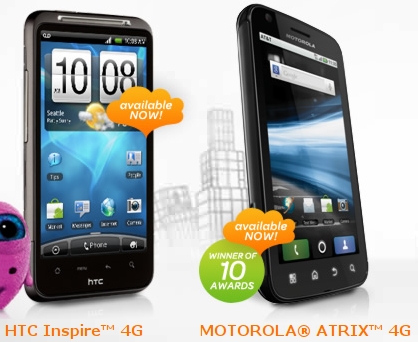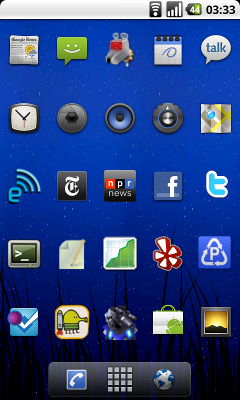A Clean, Well-Lighted Android Phone 13 years, 1 month ago by Martey Dodoo

While I remain true to my implicit promise of staying with the Nexus One until it breaks, hardware faults in the phones of two of my family members1 has put me in the position of needing to look for a new phone.
Due to previous issues of network coverage2, we use AT&T.3 Currently, AT&T's two flagship Android phones4 are the Motorola Atrix 4G and the HTC Inspire 4G (see image).
Both phones run Android 2.2 and are compatible with AT&T's HSPA+ network. More importantly (especially if I have to buy two of them), they are both approximately the same price. However, they are very different devices.
At first blush, the Motorola Atrix 4G would seem like the phone to get. It has a higher resolution display (960x540 - almost the same as the iPhone 4), a dual-core processor, a front-facing camera, and a fingerprint scanner integrated into its power button. It even has the ability to run a "webtop" dock with an integrated display and keyboard. The Inspire 4G, on the other hand, is a rehashed version of one of HTC's best phones of 2010, the Desire HD.
But like you should not judge a book by its cover, it is dangerous to judge a phone by its specifications. Longtime readers know I value openness. In this matter, the Inspire is bounds above the Atrix.
Because the Inspire is made by HTC (the most developer-friendly of all Android phone makers) and is an almost exact copy of the Desire HD, there are already third-party firmwares5 available for it. By constrast, while it is technically possible to "root" the Atrix, it is still not simple to install other firmwares.
Without knowing the benefits of openness, it might seem like the superior specifications of the Atrix would still win out over the Inspire. However, consider:
-
the Atrix 4G runs Motorola's proprietary Motoblur "enhancements", which I hate.
-
Phones that supported CyanogenMod had the option of running Android 2.3 before most manufacturers/carriers.
-
 CyanogenMod exposes more functionality than most official firmwares. Tether your phone to your computer6, get secret features like faster wireless or a FM radio, or have more customization options (e.g. multi-colored LED notifications or displaying the percentage of battery life).
CyanogenMod exposes more functionality than most official firmwares. Tether your phone to your computer6, get secret features like faster wireless or a FM radio, or have more customization options (e.g. multi-colored LED notifications or displaying the percentage of battery life). -
installing a custom firmware makes sure that the only applications running on your phone are the ones you want.
While the customization options of the Inspire make me significantly more likely to choose it over the Atrix, the fact is that it contains "last year's technology" (the only specification of the Inspire that is competitive with the Atrix is the number of megapixels of its camera, which is not particularly relevant). The ideal phone would be another Nexus model. But since the Nexus One is being no longer sold, and the Nexus S has yet not been released in an AT&T-compatible version, it seems like these two phones (along with the mediocre Android phones that AT&T released last year) are the only game in town.
Ideally, I would love it if AT&T would sell a subsidized phone similar to Google's Chrome OS netbook, the CR-48. That laptop was notable not only for a lack of bloatware in its applications, but for its clean exterior design (even bereft of a Google logo on its cover). Alas, American mobile phone carriers seem to be interested in Android devices in their money-making capacity (or at least as a counterweight to Apple's iPhone) as opposed to increasing consumer freedom.
-
Incidentally, the two affected phones are the two smartphones I previously used: the European HTC Hero (which succumbed to a touchscreen fault that seems to be a known issue, but would cost too much to fix under HTC's 1 year warranty) and the Nokia E71 (which was dropped one too many times). ↩
-
Almost two years before the introduction of the iPhone, my family switched from Verizon to AT&T because the latter carrier provided better coverage. In an alternate universe, the iPhone crippled Verizon's CDMA network, preventing their customers from even making calls in urban areas like midtown Manhattan and San Franscisco with high concentrations of iPhone users. ↩
-
Disclosure Notice: I own between 8 and 9 shares of AT&T stock. Since customer churn (people switching providers) is an extremely important part of American wireless providers' earnings reports (meaning that if I and my family's 3-digit phone bill left, T's stock price could be negatively affected), and the other large carriers are either significantly more expensive or have less network coverage, switching carriers does not seem like a good idea at this time. ↩
-
I assume that if I still had a comments section at the bottom of each article, one of my noble readers would feel the necessity to suggest that I either get an iPhone or a Windows Phone 7 phone (or a Blackberry, or an unreleased HP phone running WebOS, or some Nokia phone running a Linux derivative that they will stop supporting ten seconds after I buy it). Unfortunately, because I placed a shortcut to Angry Birds on my phone's homescreen and disabled the lock code, most of my family is firmly in the Android camp, and not willing to use a mobile operating system with less games. ↩
-
Most other mobile operating systems are locked down enough that third party firmwares are either hacked-together versions of official firmwares, or are missing critical functionality. One of the things I like about Android is that it is open enough that a true ecosystem has developed. Thanks to companies like HTC who have released device drivers for their phones, third-party firmwares are first-class citizens on Android. One of the firmwares with the strongest community is CyanogenMod. Originally developed for the first Android phone, HTC's Dream/the T-Mobile G1, it has expanded to several phones. ↩
-
It is worth noting that tethering your phone with an unofficial firmware like CyanogenMod may violate your carrier's terms of service. ↩